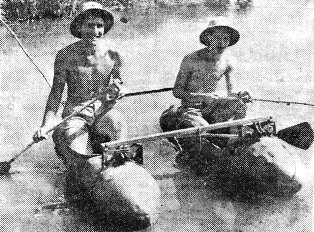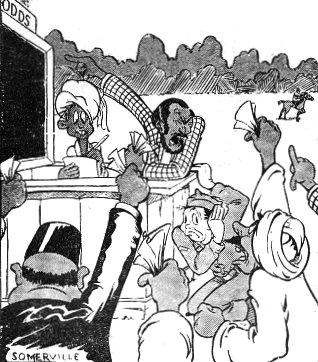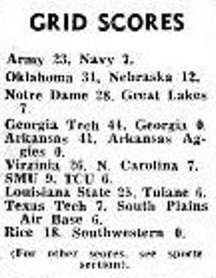

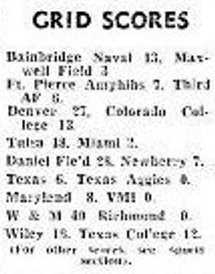
VOL. III NO. 9 REG. NO. L5015 DELHI, THURSDAY NOVEMBER 9, 1944.
|
For Uncle Joe's Sudden Recall
WASHINGTON - (ANS) - Amplifying his explanation of the recall of Gen. Joseph W. Stilwell from his triple command in the Far East, President Roosevelt declared at a news conference this week he thinks Stilwell did supremely well, that he likes the general personally and considers his record excellent. This seemed to leave little doubt that he intended no reflection on Stilwell by withdrawing him at Generalissimo Chiang Kai-shek's request.
Under-secretary of War Robert P. Patterson added, at Pittsburgh, that Stilwell is "an excellent general" and definitely is "not in disgrace."
PROMISED HIGH POST
"Gen. Stilwell," said Patterson, "is one of the outstanding men of the war and he will be given an important assignment." The promise was echoed by the President, who declared that Stilwell would be given another command, "equally important and commensurate to his high rank.
The general's recall to Washington was made with full approval of Gen. George C. Marshall, Army Chief of Staff, the President said.
Roosevelt did not elaborate on the clash of personalities between Chiang and Stilwell. He simply noted that Chiang id the head of the State, head of the government and Commander-In-Chief of the Chinese Army. He paralleled the situation with the example that if Britain assigned to Washington someone whom he (Roosevelt) disliked immensely he would tell Churchill and Britain would send somebody else. He declared it was the same in Stilwell's case. The President gave no hint one way or the other that he agreed with the merits of the Generalissimo's request.
NO CONNECTION
The coincidental resignation of Clarence E. Gauss, U.S. Ambassador to China, culminates a long-standing desire to return home, the President told reporters. It has not, he declared, even a remote connection with the Stilwell recall, and Gauss will be given a new post.
He said, according to United Press, that he did not think that anybody could make politics of the situation. That it was "just one of those things." Withdrawal of Stilwell, the Chief Executive emphasized, had no connection with matters of strategy or policy in China.
However, Rep. Walter Judd (R-Minn.) who recently visited Chungking, hurried a charge at the President that did throw the issue into the political ring. He declared that Roosevelt issued an ultimatum to Chiang that "no head of any self-respecting Government could accept." Judd claimed the ultimatum was made over the head of the War Department and by-passed Maj. Gen. Patrick Hurley, who he asserted was reporting success in his mission of "getting prompt agreement with Chiang on most of the major difficulties." The Congressman declared Chiang even tentatively agreed to appoint Stilwell overall commander but changed his mind when in a few hours Stilwell arrived with the Washington ultimatum.
Questioned about Judd's statements the President replied with a reference to a campaign of "whisperings and rumors." He told Associated Press that it may have been one of the things he was talking about in his Nov. 2 radio speech in which he said: "Hysterical, last-minute accusations of sensational revelations may develop in the closing days of the campaign, trumped up in an attempt to panic voters."
Meanwhile, Stilwell arrived in Washington. After conferring with War Department officials, he will soon take a short leave.
It was announced by the War Department that it is up to Stilwell himself to decide when and if he wants to make his story public, but that it will not suggest that he meet reporters to give his version. There is no reason, however, declared the War Department, why he should not do as he wishes.
Adm. Lord Louis Mountbatten, Maj. Gen. C. L. Chennault and Maj. Gen. Howard C. Davidson revealed that Stilwell sent them messages before his departure for the United States. They were spiced in his peculiar salty flavor.
To Mountbatten: "It is disappointing I shall not be able to finish my job in the Theater, but I am glad to have had the opportunity to play a small part in a large undertaking. I offer my best wishes for great success in your forthcoming operations. When news of that success reaches me, I shall be one of the first to throw my hat in the air."
To Davidson: "From a unit consisting of a small number of defensive aircraft the 10th Air Force has become a strong offensive organization which has wreaked havoc with Japanese supply lines and communications routes. The 10th has and is giving effective support to Allied ground troops as they advance in North Burma. As I leave this command, I extend my best wishes to all of you and shall always feel pride in your accomplishments."
In his farewell message to Chennault Stilwell praised the 14th Air Force chief for "great success under discouraging conditions," for cutting down "the Japanese air arm in China to the vanishing point," and for winning the "respect and admiration of the Chinese."
Mountbatten replied: "You are leaving behind you a reputation of being a great fighting general and I know just how much you will miss the opportunity of continuing your drive south and being in it at the finish. I always had the greatest admiration for your fighting qualities. Your telegram and good wishes were very much appreciated and I want to wish you the best of luck, whatever your assignment."
Sultan Makes Radio Address To India-Burma Troops
Roundup Staff Article
Lt. Gen. Dan I. Sultan, Commanding General of the India-Burma Theater, this week expressed his pride in the officers and men of the Theater, and his deep regret that Gen. Joseph W. Stilwell had been recalled.
In a radio address directed to all military personnel in India and Burma, Sultan paid individual tribute to those in every arm and branch of the Service.
Said Sultan: "Through all the trials and tribulations of long service in hot, alien land, you have griped, and cursed, and swore to return to the U.S. and never leave, but, through it all, you have done your job. At times you have accomplished miracles, considering the lack of resources at your disposal.
"The problems of this theater are not new to me. I have been here as second in command to Gen. Stilwell since last December. I have been up and down the Ledo Road. I have flown The Hump more than once. I was in Myitkyina when fighting was still in progress. I have been bitten by mosquitoes, sweat gallons, and wished I were home. I think I feel the same as you all do about getting back to the States.
'GET JOB DONE'
"I feel that I want to get the job done and get home without unnecessary delay, but I feel we must get that job done first. I know you feel the same."
The general pointed out that recent changes have altered neither the strategy nor the mission of those in India and Burma - rendering all possible aid to American and Chinese troops in China.
"Our job is therefore to open the Burma Road so that heavy equipment, impossible to move by air, can be gotten to the 14th Air Force. So that artillery may be gotten to the Chinese Armies. So that we may make the last concerted push, shoulder to shoulder with Gen. MacArthur and Adm. Nimitz, to end the reign of the Jap once and for all."
TRIBUTE TO MARAUDERS
Sultan also underscored that American foot-soldiers were fighting and dying in the Burma jungles, paying special tribute to the Marauders.
In conclusion, the general said: "Events in the Pacific being what they are, we can at long last see the end in view. We can see the horizon beyond which lies victory, peace and the return to normal life. We can go home proud of the fact that we have carried out a mission which has been of positive aid to our forces elsewhere. We can take certain grim pleasure in the knowledge that we have killed considerable of the enemy as we have moved along.
"This theater has been unhealthy for boys in lace pants. It has been rough, tough and disagreeable. We have fought victoriously in some of the worst jungle of this war. We have learned to work in harmony with our Allies.
"As I have said before, our mission has not changed. There is no change in either importance or emphasis. We have our job to do and we'll keep our tails up and get it done.
"It is, and has been, a great pleasure to be one of you. I am proud of you and will do my best to be a commander worthy of you."
British, Chinese Continue Two-Pronged Drive
Roundup Staff Article
British 36th Division troops of Maj. Gen. Francis W. Festing and Chinese forces, both attached to the Northern Combat Area Command under American Lt. Gen. Dan I. Sultan, continued their double-pronged offensive this week towards Katha and Bhamo, Irrawaddy River ports in North Burma.
The 36th entered and captured Mawlu, with a Scotch unit entering first led by a pipe-playing major at the head of one section. Enemy resistance at Mawlu was light as were the British casualties.
The Chinese continued probing enemy opposition in the Myothit area along the Taping River northeast of
|
IN HIGH FETTLE
The 36th took Mawlu on the night of Oct. 31. Mawlu is 47 miles southwest of Hopin and only 16 miles north of Naba Junction, where the Myitkyina-Mandalay Railroad has a branch line to Katha. The British troops are reported to be in high fettle in their drive south after the stop of the monsoon.
Since the new North Burma drive started Oct. 15, the British have had fine weather. This has been of help to them in their advance as the men are following the Myitkyina-Mandalay Railroad and the accompanying road and had to plow their way through stretches of thick jungle. In the last 30 days of fighting, the Division has advanced 100 miles, with light casualties.
COLORFUL LEADERS
Americans with Festing's outfit in its drive are such colorful military men as Brig. H. C. Stockwell, who took part in a commando raid on Norway, where he won the DSO; Brigadier A. R. Aslett, who was an international rugby representative 20 years ago.
In the Chin Hills area, the Fifth Indian Division stormed and captured Vital Corner on the Tiddim-Ft. White Road. The Fifth and other elements of the British 14th Army are now on the approaches to the formidable Kennedy Peak, where the Japs are strongly entrenched.
In the Arakan during the week, there has been patrol activity and artillery exchanges.
Army News Service announced from London that Sir Oliver Leese, commander of the Eighth Army in Italy, has been appointed commander of the newly organized 11th Army Group, which will operate in the Southeast Asia Command under Adm. Lord Louis Mountbatten.
CHINESE ANNOUNCE JAPS IN KWEILIN
CHUNGKING - The Japanese this week were reported to be concentrating their main efforts on the railroad city of Liuchow, converging on it from three directions, with the nearest column only 45 miles away.
The Chinese High Command also announced this week that enemy troops have fought their way into the northern railway station of Kweilin, capital of Kwangsi Province. Americans have completed demolition of the 14th Air Force field at Kweilin, with the demolition squad escaping by jeep this week, after a pilot reported the approach of 2,000 Nip cavalry from the direction of Kweipin, only 15 miles to the east.
The Chinese claimed to have struck at the Jap rear and seized Tzeyuan, 80 miles northeast of the front. The Chinese claim to have seized quantities of enemy supplies in Tzeyuan and to have taken Ningyan in Hunan Province. The Chinese also claim to have repulsed attacks six miles west of Foochow in Fukien Province.
DONALD NELSON TO RETURN TO CHINA
WASHINGTON - (ANS) - President Roosevelt this week directed Donald M. Nelson to return to China at "the earliest possible date" to organize a war production board for the Chinese.
After a long conference between Nelson and the President, the White House issued a statement saying that Nelson "would continue his work with Generalissimo Chiang Kai-shek on measures aimed at strengthening the Chinese war effort."
Nelson, according to the White House, returns to China at Chiang's request. Nelson will be accompanied by Howard Coonley, WPB executive, Eugene Stallings, alcohol production expert, and a mission of five steel experts, headed by Hergert Graham, chief metallurgist of the Jones-Laughlin Steel Co.
As the President's personal representative, Nelson will assist Chiang in organizing a board to increase the outpost of China's war industries.
By S/SGT. EDGAR LAYTHA Roundup Field Correspondent
Some 200 miles north of Calcutta, the trains are transshipped to a narrower gauge. There G.I.'s take over the vital Bengal and Assam Railway, the Allies' lifeline to the Far East's mainland fighting fronts. Young Americans recruited into Railroad Operating Battalions, many still in their teens and early twenties, are the engineers, conductors, stationmasters, train dispatchers, track maintainers, yard masters, yard clerks, brakemen, signal maintainers, switchmen, block operators, pipe fitters and machinists of the railroad. Their officers are the chief dispatchers, signal supervisors, train masters, track engineers and transportation chiefs. In the dark days of China, these G.I. railroaders supported effectively the ATC's Hump operations by hauling the bulk of fuels and lubricants that kept the planes running. During the threatened Jap breakthrough at Imphal, the G.I. Railway was the chief medium in shipping British armies and equipment to meet the attack.

Commanding General, Transportation Corps |
At Parbatipur, the first great G.I. terminal, we begin to witness a familiar story. Yanks strike up the band and it becomes an American symphony all the way to Ledo. Personnel and military supplies, American and British, are moved from here to Upper Assam. G.I.'s supervise the handling of the stores, the operation of the crane lines, check the minimum delays of dozens of trains a day coming down empty, moving up full. They are the brains behind the cranes which lift the airplane engines and maintenance trucks over the heads of working coolies as if they were made of cellophane. They boss the hundreds of Indian workers in the yard who unload the cars and transport the goods on their bare heads to up-trains. These coolie-heads carry virtually everything that is needed to keep a front fighting. For instance, huge loads of Downflakes - potassium chloride - to keep down the dust on the Ledo Road. Heavy Downflakes are carried on the heads of two men. This two-headed carrier gait, like in a modern eerie ballet, remains light and elastic under the incredible weight. So they dance about against a background of American MacArthur locomotives and refrigerator cars.
Besides several thousands of cars of all types, we have brought over hundreds of these big engines since the G.I.'s began to operate the railroad last March. The refrigerator cars, however, which haul frozen meat into the forward areas, are common War Department box cars rebuilt for their new purpose somewhere in Bengal by one of the G.I. shop battalions.
The great marshalling yard is smoky and grey. It smells of oil and sweat and yet, believe it or not, many of the G.I. engineers prefer to work in khaki. When you mount a MacArthur you'll know why. It shines and glitters as if it was an exhibition piece. So are the camps where the railroaders live and so is their food. They eat no more different food than the average soldier, but it is prepared with the care of your mother's kitchen. And so are the men. They brought an attractive civility and sobriety with them from pre-war life. They feel hosts and see a guest in you if you happen to travel on their line. As most of them were railroaders back home, they obviously like their job and bitch less than you and I. Last March, when their camp in Parbatipur burned to the bottom and all their belongings perished, the men went out into the yards in shorts and sandals. Result: Not a single delay.
A night ride from Parbatipur swallow's the tedious rice-belt of Bengal. You awake in Assam and meet the Brahmaputra in a countryside picturesque and pretty. Green islands rise in the wide river. Hindu temples, Moslem shrines and airy bashas top the wooden hills on the other bank. U.S. second lieutenants criss-cross the Brahmaputra in American-made speedboats, direct, speed up the operations. And the wagons are ferried over the river far faster than they have ever been ferried before.
In the motley crowd across the river, the weather-beaten veterans of the British 14th Army, Ghurkas, Sikhs, Senegalese, West Africans, Burmese and Englishmen stream from the ferry into northbound trains. And with them, Yanks and the Chinese.
The railroaders who operate in this district will tell you weird stories of cobras and tigers, stories which grow more and more fanciful the farther up you travel. There are case histories of picture shows broken up by the appearance of a King Cobra or of the guy who killed a rhinoceros in self-defense. Tiger and leopard skins, mounted and unmounted, will prove the tales. As to the rhinoceros, the British claimed hide and tusk. But you'll like the case of a G.I. stationmaster who had to let a tiger go.
It happened at midnight. A train couldn't go into a siding to meet another train. The controller from Battalion Headquarters telephoned to the jungle, asked why the delay. Sgt. G. A. Blake, of New Hampshire, lamented from the other end about a tiger who was eating a cow right on the rails. The midnight supper lasted 32 minutes and, as the sergeant had only a pistol, traffic had to be suspended all this time and the war had to wait until the tiger retired.
In a sheltered valley somewhat off the line lies the railroaders' headquarters, from where a Railway Grand Division runs the entire show. It's a pretty snappy outfit: Close order drills, reveille, retreat formations and separate tables for the upper three grades in the mess.
Responsible for this slightly martial touch and also for the disappearance of all personnel bearers along the line is the Director of the Military Railway Service, TC: West Point bred Brig. Gen. Paul F. Yount. Oddly, the commanding general of the M.R.S. is no ex-railwayman, although he was awarded the Distinguished Service Medal for outstanding performance of duties when he was in charge of another G.I. railroad: The Trans-Iranian Railway in the Persian Gulf Command, which ships Lend-Lease to Stalin's armies. Talking to the 36-year-old general, you seem to sit in front of a kindly first sergeant, and so also feel his men, despite the four hours of military training a week he happened to prescribe. The general, too, likes his railroaders. They are the same type of men, he thinks, as the guys he commanded in Persia. Only the country is different. In Persia, the G.I. froze in the mountain ranges at 40 below and sweat afterwards when his train hit a 130-above desert. But the purpose of the two G.I. Railways is similar.
We took over the Bengal and Assam Railway, the former outlet for Assamese tea gardens, at the request of our British Allies, who could not spare enough trained personnel without jeopardizing their other Indian railways. Our task was tough. Besides transporting personnel, we had to haul the material and equipment for the construction of the Ledo Road, for the defense of those construction forces, for the Burma campaign, for the defense of India, and lastly for the aid to China. At the time we took over, the Jap was at the gates of India and the railway upon which the fate of India depended was equipped at places with installations used in the United States some 60 years ago. We had to act in a hurry and there was no time for radical changes in operating methods. The M.R.S. (Military Railway Service) decided to train American forces in Indian methods rather than change thousands of Indians. The G.I. Indianized himself. He concentrated mainly on the intensification of the efforts to eliminate delays in terminals and en route. Freight trains which needed a week to do a stretch suddenly did it in four hours. Finally, it was the additional Lend-Lease equipment of thousands of cars and engines which helped to increase the tonnage by 200 percent since March 1, 1944.
In spite of American magic, the trains still ride pretty slow, depending on their priorities. Low priority trains have to hide and wait patiently in innumerable sidings until the so-called Snapp trains roll by. I rode the engine of a low priority train from the Brahmaputra to a jungle yard and the 100-mile stretch took us 16 hours.
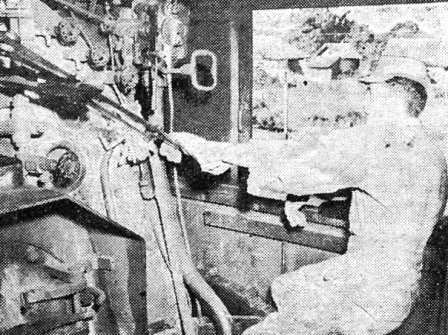
G.I. Engineer from Pennsylvania |
The 65-car-long train carrying several millions of dollars worth of supplies, was in charge of two G.I.'s assisted by two Indian firemen. The engineer, Cpl. G. P. Moffet, 21, of North Carolina, took orders from Pvt. Orville C. Vick, 23, of Connecticut, the conductor. Vick was responsible for the safety of all the cars; he had to see that all the markers were up, give the signal for departures, write the delay reports and seal a train.
Our MacArthur cut through a world lush and green. Unexplainably thin cattle grazed on rich pastures. Water buffaloes swam in sleepy lagoons. Even they seemed gaunt and starved, so unlike their cousins in the Chinese rice lakes. Then came the jungle, like Hudson's "Green Mansions," beautifully forbidding. Richly overgrowing foliage enwrapped the dense forest. A fancy bird would fly out now and then, sit on the telegraph wires, look at us, then return into the thicket. During the monsoon, tells the engineer, cub tigers and full grown leopards used to linger on his track, as if it was their playground.
The G.I. stationmasters at the lonesome places, where we had to wait for the Snapps, sipped hot coffee and spoke of their solitary lives. Some traded beer to the natives for one egg-laying hen per bottle. And again we heard the old hunting stories, but much bolder now, of tigers, wild boar and deer. But a new beast entered the picture: The wild, jungle-roaming, basha-piercing, native-chasing elephant.
In a sunny siding we ran into THE PILGRIM, Chaplain Ervin H. Hartman's rolling church, office and home. THE PILGRIM is switched on and off trains at places where it is most desired. At intermediate stations, services are held in the car for as few as three men. A white cross on blue background is painted on both sides of the former saloon car, now equipped with an altar, an Army field organ and a kitchen where Cpl. Thomas G. House, the chaplain's assistant, cooks his and his superior's meals. The corporal, who studied for the ministry while he was a yard switchman in Missouri, has now the job of his dreams.
The next stop of importance is a highly-congested marshalling yard, where Americans handle a great many trains in a day. It is carved right out of the heart of the jungle. No roads, no airfields - rail is the only approach. It's a malaria hotbed, a cobra rendezvous. In peacetime they sent the inefficient railroad officials to be stationed here. Not so now. The yard has our best men, who have to cope with the most difficult terrain, for the track is just hell from here, says their C.O.
Two-thirds of the 766-mile Calcutta-Ledo odyssey is behind us. It's only 250 more miles to Ledo. I am riding a Snapp train. From here on it's hell - said the yard's C.O. It certainly looks so. The track seems to have been sunk into a zigzagging uphill-climbing mountain gorge. Near the curves still lie the wreckages of past tragedies. I sit at the controls of a train riding Ledo-bound maintenance truck. It's a honey of a seat, but I see nothing, for thick fog envelopes us from all sides. The seriousness of the situation is accentuated by rank and age of personnel. The engineer, in his 30's, is T/Sgt. Bennie L. Angwin, of Birmingham, Ala. The conductor: Sgt. Edward L. Hehemeyer, of Hannibal, Mo. They curse the fog and curse the land, but bring the Snapp safely into Manipur Road where, with dynamic suddenness, the atmosphere about you points to the close proximity of the front.
Everything belonging to our British Allies, men, equipment, and supplies, leaves the trains and takes the motor road to nearby Imphal. We are at the point on the railroad where a Jap breakthrough last spring seemed almost inevitable. They had a road block only six miles away. At that time the G.I. camp moved into the barricaded station.
The country from Manipur Road on offers little new. The jungle is the same, so are the jungle stories. But we meet Virginia and Maxine, the beloved two-car Red Cross Trainmobile patched together from old scrap by G.I.'s. Virginia and Maxine stands for the two Red Cross girls whose home it is: Virginia Keadle (Williamsburg,

Chaplain's Assistant |
We roll into the last great G.I. terminal: Tinsukia, less than 50 miles from Ledo. Here the trains are broken up and sent in several directions to airfields, warehouses and road terminals. The railway battalion in this hotspot is prideful of one of the swankest rec halls in the Far East. On a floodlit, be-curtained stage, a swing band of railroaders off-duty entertains.
On the last stretch to Ledo, the most fascinating beats round out the journey's zoological collection: the freelance elephants, who live independently and undisturbed in the jungle, subject only to occasional calls for duty. The railroaders use them as living switch engines for they are capable of pushing five to eight-car trains into a siding. You can't believe it until you have seen the performance. I have. An Indian boy who works for us gave the Moslem version of the Tarzan yell and added the word: "Bilbo." We waited a few minutes... then the foliage parted and in all his towering immensity, "Bilbo," the strongest of the living switch engines, walked into the yard. A sergeant told him to clear the yard of a dozen empty cars, supported his words with motions. Bilbo did it, then stretched his trunk and walked back into the thicket. Bilbo and his fellow elephants do these things year in, year out for nothing, not even a bite to swallow. There is, of course, a clue to this gracious altruism of the freelance elephants. They are the remainders of India's famous working elephants who lost their job some 20 years ago through the advancing machine age. Bilbo, for instance, must have been owned at that time by one of the tea gardens until he regained his freedom. And an elephant never forgets.
Came Ledo, the end of our travels, but with Ledo the activities of the G.I. railroaders do not end. They work in Burma, even in China. One of their units operates the railway between Myitkyina and Mogaung. What they did and what they deserve has been appreciated recently in a letter by Gen. George C. Marshall to Gen. Joseph W. Stilwell. Wrote Marshall: "Dear Stilwell: General Somervell has reported to me the splendid record which has been made in handling of transportation both in Calcutta and along the Assam line of communication... All of this indicates that your transportation people have done an outstanding job, despite many difficulties not normally encountered in other theaters. Please pass along to those who have been directly employed on the work my congratulations and appreciation." Uncle Joe passed the letter to Maj. Gen. W. E. R. Covell, and this was his footnote: "Please see that the responsible people get a pat on the back."
 INFANTRY IN CHINA
INFANTRY IN CHINA
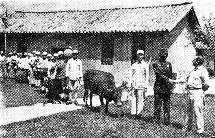 Col. H. M. Henry, commanding the Y-Force Infantry Training School, receives birthday gifts from Maj. Gen. Young Hong Yun.
Col. H. M. Henry, commanding the Y-Force Infantry Training School, receives birthday gifts from Maj. Gen. Young Hong Yun.
|
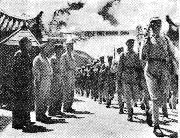 Maj. Gen. Chang Chi, Col. H. M. Arthur and Col. Kuo Fung Chien, inspect Chinese troops in training at Little Fort
Benning.
Maj. Gen. Chang Chi, Col. H. M. Arthur and Col. Kuo Fung Chien, inspect Chinese troops in training at Little Fort
Benning.
|
 Cpl. Reuben R. Mattern of the Y-Force Operations Staff and Maj. Ku Y Hen, Chinese Army, supervise assembly of 75mm
pack howitzer.
Cpl. Reuben R. Mattern of the Y-Force Operations Staff and Maj. Ku Y Hen, Chinese Army, supervise assembly of 75mm
pack howitzer.
|
HQS., Y-FORCE OPERATIONS STAFF, CHINA - When the Y-Force Operations Staff, American military mission to China, set up the first modern infantry training school for the Chinese Army in southwest China, the Americans christened it "Little Fort Benning."
Graduates of the school return to their outfits at the front and themselves proceed to instruct their comrades in the methods of carrying on modern warfare as taught at the Infantry Training School.
Little Fort Benning is the headquarters of Col. Philip H. Enslow, who has been in the Far East since December, 1942. Commandant of the school is Col. H. M. Arthur who named Little Fort Benning. Located not far from the Indo-China border, it is one of the numerous far-flung posts of Brig. Gen. Frank Dorn's Y-Force Operations Staff.
Monsoon rains do not discommode the present G.I. residents, for there are paved walks between buildings, and the grass squares enclosed by these walks make excellent spots for sunbathing, another American practice which the Chinese find difficulty in fathoming.
MOVIES . . . SOMETIMES
Furniture, while neither luxurious nor entirely ample, is a considerable improvement over that available at most outposts. Even an occasional wooden arm-chair appears.
A large theater is available when infrequent films arrive.
Movies are attended by as many Chinese as can crowd into the theater. Word of the arrival of a new film circulates by Chinese grapevine so rapidly that citizens of the nearby town usually know of the performance before the Americans in the compound have discovered it.
From the Americans who have acted as instructors at Little Fort Benning have been formed small traveling units to instruct various units of the Chinese Army. At present there are several teams of officers and men each instructing and supervising instruction and training in Chinese units.
These teams must sometime travel as many as four or five days by pack animal in wild, hilly, jungle country where trails are often only 12 or 18 inches wide in order to join the outfit to which they are assigned. As one officer expresses it, the hills are "up and down but mostly up," and there are frequently drops of one thousand feet should a foot slip on the trail.
SPECIAL INSTRUCTION
The Americans of the liaison group have given instruction in seven basic subjects - weapons, tactics, medicine, veterinary medicine, signal communication, ordnance and chemical warfare - and were probably the first to train Chinese on courses requiring the use of live ammunition.
Lt. Col. J. M. Neville is Little Fort Benning's Executive Officer. Medical matters are administered by Lt. Col. Thomas A. Baines who treats Chinese as well as Americans in his daily clinic. Ordnance affairs are supervised by Lt. Col. J. H. Travers Jr. Capt. James R. Miller and Capt. D. E. Skogstrom handle communications.
Sketchy Raids By Japanese On Myitkyina
By JACK GUINN United Press Correspondent
MYITKYINA - (Delayed) - Japanese aircraft bombed Myitkyina airfield a few nights ago, it was made public this week. Several American planes were damaged slightly. A couple of nights after, a few Jap planes returned and circled the Myitkyina area, but dropped no bombs and succeeded only in worrying Americans, who spent most of the night under shelter.
The Myitkyina raid, coupled with recent other Jap raids in this neck of the war, seem to indicate that Japanese air strength in North Burma has either been withdrawn or done in. Like other raids, it was small, inaccurate and ineffective.
ATTACKS DWINDLED
Just before the fall of Myitkyina, Jap air attacks dwindled to almost nothing. Jap bombers then had been intercepted and shot down on such a scale that attack wasn't worthwhile any more.
Recently, the Japanese have directed minor bombing attacks against B-29 fields in China, but they have been similar to those at Myitkyina - weak and ineffective and doing more damage to cabbage patches and rice paddies than to their targets.
ANYBODY'S GUESS
What the Japs have done with their air force is anybody's guess. Maybe all they could spare in Burma have been shot down. Maybe all not shot down have been withdrawn to China or Japan to ward off attacks there. Maybe the former Burma planes even took part recently in the Philippines defense.
But whatever, the Jap air force in Burma doesn't amount to much. One fighter pilot reported some time ago that he'd flown more than 100 missions - once going as far as Rangoon - and had yet to see his first Jap plane.
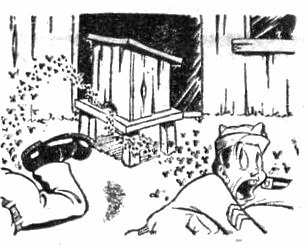
|
OF DISAPPROVAL OVER BEES
To the disapproval of his buddies, T/Sgt. Sam Anderson, stationed with an Engineer outfit in India, took to the hobby of honey gathering a while back, and set up a hive at the entrance of his sleeping quarters. Watching the numerous bees which buzz around the mess hall, the idea dawned on Sammy that nothing would be better to insure peace and quiet than a fortress of stingers at the front door.
So Sam improvised a hive and, clad in hood, gloves and numerous other safety devices, induced the queen and her workers to take over their new home. They did and Sammy could peacefully recline on his bunk, unbothered by guests.
His solitude didn't last. The bees left shortly after, so did his privacy, leaving with an embittered Andy the poignancy of yesterday's honey in an empty hive.
There is a happy ending to this story - for his buddies. They can now enter his quarters at will, without the necessity of running the gauntlet of bees.
In an effort to forget his "lost love," Sammy has turned to the less hazardous pastime of collecting butterflies. Morning, noon or night, you can find Sammy, sans the safety devices, armed only with a net, blithely chasing the elusive "Lepidoptera." What a war!
ALL-CHINESE BOMB CREWS GRADUATED
PUEBLO, COLO. - (ANS) - The first all-Chinese aerial bombardment crews to be trained in the U.S. are now ready to fly American bombers against the Japanese.
Ten of these crews received their graduation diplomas this week at the Pueblo Army Air Base, the only Chinese training base in the U.S.
14th Air Force Takes Heavy Jap Toll
Roundup Staff Article
Overcast skies curtailed operations of 14th Air Force fighters and bombers in the Kweilin and West River battle areas for much of the week, but Maj. Gen. C. L. Chennault's aircraft nevertheless took a heavy toll of Japanese troops on the roads and river near the Kwangsi Province capital.
P-40's hit a concentration of 1,500 enemy soldiers and 300 horses near Yungfu on the railroad 20 miles south of Kweilin, and also bombed and strafed Japs in the Tashu area, 10 miles southeast, and struck at Pinglo, In all, over 450 Nips were claimed killed, as well as 115 horses, with eight tanks damaged.
In another strike earlier in the week, fighters strafed a troop ferrying operation on the Siang River near Kiyang, and also shot up a nearby truck convoy, claiming 475 troops and 105 horses killed, plus 51 trucks destroyed. P-51's caught a two-mile Jap pack train in a canyon nine miles west of Konghow and strafed it. Then P-40's dropped frag bombs to block both ends of the canyon and repeatedly shop up the trapped enemy. Five hundred Jap soldiers and 200 horses were claimed killed.
FURNISH SUPPORT
Other planes furnished heavy air support on the Salween front, hitting targets in the Mangshih-Lungling area as Chinese troops captured the latter city. P-33's bombed the Hsenwi bridge on the Burma Road and destroyed the Monghu bridge south of Wanling.
The 14th was unusually active on the Yellow River front, knocking out two spans of the Yellow River bridge on the main Peiping-Hankow railroad. B-25's of the Chinese-American Composite Wing flew clear to Pengpu, northwest of Nanking, to destroy two abutments of the rail bridge there, while other missions hit the
|
PLANES DESTROYED
One flight returning home caught escorted Jap bombers landing at Kingmen and went after them. They shot down five bombers and 11 fighters, destroyed four more bombers on the ground. During an attempted Jap raid on an American northern base, one Nip bomber was downed, while P-51's on shipping reconnaissance over Amoy, in the south, wrote off two enemy fighters.
Fighters sweeping Amoy and Swatow attacked three freighters and a large vessel in Amoy harbor. One freighter was sunk, another left afire. Airfields at both sites were strafed, as well as those at Kiungshan on Hainan Islands and Gia Lam near Hanoi in French Indo-China on other missions during the week.
A Japanese destroyer was sunk and a large transport left listing in two missions by B-24's against a convoy in the South China Sea east of Hainan Island.
Nine 14th Air Force planes were lost in the week's operations.
EAC Pounds Enemy With Savage Fury
Roundup Staff Article
Eastern Air Command operations the past week were of an unusually heavy nature, concentrated on the destruction of key objectives along Jap lines of communication in Burma; supporting ground troops on the North Burma front; and sweeping enemy airfields to prevent concentration of hostile aircraft.
Most spectacular mission was the two-day assault against Rangoon by a combined operation of B-29's and EAC fighters and bombers. In the attack on key objectives in Rangoon, the same strategy that was so successful in Formosa was followed.
First, 10th Air Force P-38's and RAF Thunderbolts of the Third Tactical Air Force shot up shelters and hangars at Hmawbi and Mingaladon Airfields. The Super-Forts then hit the Mahlwagon yards. Following this attack, P-47's of an Air Commando Group attacked Hmawbi, Mingaladon and Zayatkwin, where they destroyed one Jap aircraft and damaged four in the air and on the ground.
LIBERATORS ACTIVE
The next day, railway workshops at Insein suffered direct hits when RAF Liberators of the Strategic Air Force pounded the area. Fighters of the Third Tactical Air Force destroyed three and damaged five Jap aircraft in the air and damaged one on the ground while escorting the Libs. The fighters swept the same airfields as were covered in the previous day's operations with the B-29's. Considerable damage was done to airfield installations.
In coordination with the two-day attacks against Rangoon, fighters and medium bombers of the 10th Air Force and Third Tactical Air Force based in North Burma swept airfields in the Mandalay area to pin down the air defense in Central Burma. Among the fields attacked were Shwebo, Nawnghkio, Onbauk, Meiktila and Thebaw.
Other targets were also hit in Burma, Thailand and French Indo-China. One mission of RAF Libs attacked the Makasan Branch Railroad workshops in Bangkok at night leaving them ablaze and causing large secondary explosions. Another flight of the same mission hit the airfield and shipyards at Vinh, 100 miles south of Hanoi on the South China Sea, with fires visible for 20 miles after the raid.
DARA BRIDGE GOES
Earlier in the week a volunteer mission of B-24's from the veteran Seventh Bomb Group destroyed a bridge at Dara, one of the key stations on the Bangkok-Chiengmai Railroad, with more than 100 feet of the structure observed lying in the Menam Nam River after the attack. Destruction of this bridge meant the Japs would have to transship supplies and troops across the river and will seriously interfere with their communications into Eastern Burma. One aircraft of this flight, with three bombs left in its bay, made three unsuccessful runs when its bomb mechanism failed to function. But on the fourth run three direct hits were reported.
P-47's of Maj. Gen. Howard C. Davidson's 10th Air Force, in addition to their usual effective support of ground troops, destroyed a number of bridges, including those at Wuntho, Nyangwun, Kudon and in the Indaw area. The bridge-smashing B-25's of the 490th Squadron lived up to their reputation by destroying or damaging bridges at Namkhai, Nankan, Thegyaung, Okkyin, Zawchaung, Hsenwi and Kawnghka.
In the Kennedy Peak-Fort White area, which is under attack by the 14th Army, Hurricanes and Thunderbolts of the Third Tactical Air Force averaged more than 150 missions daily, the former giving direct support to ground troops and the latter beating up airfields around Mandalay. Kennedy Peak was also hit by B-25's of the 10th Air Force with smoke from the attack rising more than 3,000 feet in the air.
In many parts of Burma, the Jap was able to move only under cover of darkness due to the constant air harassing. To counteract this Beaufighters made several night attacks against rail and road transport south of Mandalay.

|
MYITKYINA - To win the Battle of North Burma and capture this, its largest city, men of Merrill's Marauders, when they could not knock out a Jap pillbox, would go in, drag out the Nipponese occupants and shoot them.
They did enough other things to make herpes the rule rather than the exception in this outfit.
Some of these heroes had the experience of walking up to Japanese and shaking hands with them in broad daylight, believing they were Chinese (since they were in Chinese uniforms) then fighting their way out of the ambush.
One man was dug in for 35 days in front of one Japanese pillbox, another did not change clothes for 50 days. One non-com, who started the campaign as technical sergeant and a weight of 192 pounds, emerged after 67 days as a second lieutenant and with a weight of 138 pounds.
One group of men worked steadily for nine days and nights carrying ammunition and water to the front lines. Men averaged four to five hours sleep per night. One man made his bed on a Jap pillbox one night with the Japs inside, but fortunately, he arose earlier the next morning than his subterranean enemies.
These are some of the things which these men went through to wrest North Burma, and Myitkyina, back from the Japanese.
S/Sgts. Richard Archer, Eugene Meeks, and Bill Petro formed the trio which invaded the Nip pillboxes when they could not blast them out, but Archer was also adept at destroying the Nips with grenades. With the assistance of his buddies, he blew up seven Jap pillboxes on day in an hour and a half, killing 12 Japs. Archer's buddies maintain that he learned to toss grenades accurately b tossing cream puffs at an Atlanta, Ga. bakery before he got in the Army.
While men like these three went below ground at times to come to grips with the enemy, others came face to face with the Nips, believing them to be Chinese troops. This occurred near Sitapur when one company of the Marauders was ambushed by the Japs one morning. Men of this company were supposed to make contact with the Chinese in that vicinity. Pfc. Bud Velardo and Pvt. Raymond L. Ricardo were among the 180 who walked into the Jap ambush and were among the 77 who walked out.
Japs, dressed in Chinese uniforms, came out of the bamboo and brush in the vicinity where contact was to have been made with the Chinese. Some of the Japs came out, shook hands with members of the company, other Japs from the brush opened fire. Both Velardo and Ricardo shook hands with the Japs.
Ricardo went down a hill alone to talk to a group of six Japs. He suspected something was wrong when he felt the edge of a bayonet prick his back. He cut his finger on the sharp blade as he knocked it away, the force of his arm felling the Jap. The Japs opened fire amid a rush for the ground and cover. Ricardo was the only non-com left, and he led 77 men out through the rice paddies, many getting out only after darkness had fallen. The men killed there were revenged later when 90 Japs were killed at this spot.
T/Sgt. Patrick Murphy, who was dug in for 35 days in front of one Jap dugout, is a platoon leader who sometimes went on expeditions with Archer, Meeks, and Petro to yank Japs out of their pillboxes. Three of his platoon commanders were killed during the campaign. He fought for 42 days during the Myitkyina campaign, getting an average of four hours of sleep per night and eating C and K rations during that period. Murphy, who did not change clothes for 50 days, having only one suit of fatigues, was in charge of his platoon when it accounted for 50 dead Japs in two days.
But the best platoon leader in the outfit is conceded to be Lt. Howard Thibault, who lost only one man killed and five wounded during his 67 days of platoon leadership. Tibault, who was commissioned a second lieutenant from technical sergeant in the field in August, suffered from malaria during the campaign, his weight dropping from 192 to 138 during the nine weeks he was in the fight. He managed to keep going on "a regular diet of atabrine tablets" and went to the hospital the second day after the campaign was over.
Thibault attributes the success of his platoon to the fact that each man in his command was armed with either a Bren gun, BAR, or Tommygun, with the exception of three; but men and officers of the Marauders point instead to the training which he gave them while the platoon was placed on a road block assignment. Thibault, who has had seven years experience in the Army, half of that time in Panama, took entirely green troops, and, in three weeks, by training from dawn until dusk while the platoon was on road block duty, gave the troops the same amount of training they would have received in Panama jungle training in 14 weeks.
Not only is Thibault acknowledged to be the best platoon leader, but also the best man in the outfit on personal intelligence and reconnaissance missions.
"Men used to bet on whether or not I'd come back off some of my missions," Thibault said with a grin recently while in the midst of censoring letters. He evolved a way of locating the exact position of Jap pillboxes in the Myitkyina area. In many places these underground dugouts were camouflaged perfectly by the natural jungle growth. "A man would be within two feet of one before he'd see it," Thibault said. "They could not be seen by the normal use of field glasses."
However, the lieutenant did locate the pillboxes by the use of field glasses. He would crawl into a rice paddy, but instead of shifting his glasses about, he would hold them exactly on one spot for 15 or 20 minutes. When Japs inside the pillboxes would light a cigarette, smoke would drift out of the aperture and could be plainly seen. He located many this way.
Thibault may have located them, but it took Pfc. Tom Speakman to kill them. After sleeping on a Jap pillbox one night, he awoke just before the lone Jap occupant came out. He not only got him, but at another time killed seven Japs in one pillbox and once tossed 72 grenades in one hour.
S/Sgt. Charles Cattaneo, Pvt. Bob Hollman, and T/5 John Lupetin don't know how many Japs they accounted for, but Pvt. John Caratti, four feet 10 inches tall, the smallest man in the outfit, killed five sons of Nippon himself.
Worried About Xmas Gifts? Here's An Idea
By Cpl. CHARLES W. CLARK
If you have been lying awake nights wondering frantically what to send the folks for Christmas, the Roundup has a suggestion, one that may be the answer to "What would they really like to have?"
Our suggestion is this: Save all your cigarette butts for a period of say, two weeks, wrap them carefully in a bright Christmas box and send them to the mama, papa, brother, sister or girlfriend. They'll love you for it!
If that seems to be typical Roundup precocity, then bear with us and read of the truly horrible plight of your dear ones sweating out the war back on Woodrow Street.
Back in Shangri-La, they just ain't got no cigarettes.
A cigarette official of the War Food Administration announced this week that the United States "has reached the very bottom" of its scanty tobacco supply. And, to make matters worse, a group of unscrupulous cads have cornered a big percentage of what few cigarettes are now available and are asking exorbitant prices for the weed on the black markets.
With disbelief in their hearts, reporters for the United Press roamed the streets of the major cities across the nation to check on the situation. The findings of those sleuths will tear your hearts out.
One reporter visited 19 stores in the business district of Atlanta, Ga. No cigarettes. A survey of 14 stores in Chicago revealed no popular brands, only a few packs of unfamiliar name. Along Manhattan's 42nd St., 14 stores were canvassed. Two had a few packs of Camels and Chesterfields, eight had no cigarettes at all and the rest had only the unfamiliar brands. The whole San Francisco Bay area was plastered with "no cigarettes" signs.
A touching situation, huh, chum?
If you should return home (oh happy day!) and find The Blonde waiting at the train station, don't be surprised if she is sporting a new briar pipe. So help us, the UP reports that in Cleveland women are buying pipes for their personal use, while on the campus of the University of Tennessee, co-eds stroll nonchalantly along with "Dogpatch-style" corn cobs clinched tightly between their pearly teeth.
To offset this dreary scene on the home front, the Agriculture Department predicted that this year's tobacco crop may be the second largest on record.
But, be that as it may, civilians at home are finally realizing that war, by gum, is pure hell!
HISTORIC WILD WEST RODEO HELD IN RAMGARH
RAMGARH TRAINING CENTER - Under a burning Indian sun and in clouds of dust from a timeless continent, the U.S. Army last week scored another interesting if not historic premiere for this part of the world when it presented the first Wild West Rodeo ever staged in Asia.
It was a case of East meets West with a vengeance, out here in the wide open spaces of Bihar Province, as a motley audience of 2,000 American G.I.'s, Indian sepoys, Chinese "bingpos," British Tommies and a miscellany of civilians watched a fast-moving, hell-for-leather two hours of dramatic action which, despite the difficulties of staging the performance 12,000 miles from its rightful habitat, in many respects equaled and in some comedy aspects surpassed the same article at home.
Dreamed up by a Quartermaster Remount outfit stationed at this camp, the performance was a brilliant surprise to the sophisticates of the audience who had drifted out in anticipation of a typically bungling amateur performance. From the opening Grand Entry to the final event, proceedings moved with a professional finesse which attested more powerfully than the printed programs to the fact that more than a dozen of the remount soldiers were professional rodeo entertainers in peacetime at home.
Led by Lt. Howard (King) Mayfield, professional rodeo rider of Estes Park, Colo., who supervised the production and emceed at the public address microphone during the performance, and the amiable clowning throughout the entire show of S/Sgt. Arnold A. (Hatless Snafu) Hexom, of Wakon, Ia., the show had everything from bareback mule riding, bronco busting, steer roping and bulldogging to special trick riders, rope artists and a jumping mule which, with Sgt. Walter L. Greery of Richmond, Va., up, leaped spectacularly over a flaming barrier.
Conducted in strict accordance with Rodeo Association of America rules, riders from a dozen states - California, Tennessee, Iowa, Virginia, Texas, Montana, Oklahoma, South Dakota, Idaho, New Mexico, Illinois and Connecticut - participated. Winner of the major cash prizes, handed out at the end of the show by Brig. Gen. Frederick McCabe, was Bud Evans of Plano, tax., who won top honors of the saddle bronc, bare-back bronc and bare-back mule events and took second in steer riding.
|
Main difficulty faced by the rodeo impresarios was the lack of true Wild West livestock to test the full skill of the riders. This was overcome with notable success in the case of local mules and horses, aided by adept use of the spurs to a spirited performance, but many of the Brahma steers took a strictly naymallum attitude toward the whole affair. Several of these lay quietly down in their tracks when the G.I. cowboys attempted to put them through their paces, while one carried its Gandhi passive resistance movement to the extent of retiring into the audience and watching most of the remainder of the performance as one of the spectators.
During lulls in the entertainment, Ramgarh's famous "Mountain Ramblers," an organization of rustic musicians, gave forth hot and sweet over the loud-speaker microphones. Another musical specialty was the crooning of Sgt. "Smokey" Gogue, of the Hollywood films, who is equally at home in the saddle and before the mike. Trick rider Cpl. Matthews gave a finished performance of handstands and on-and-off riding in spite of a sandy footing which added to the difficulties of his performance, and rope specialist Cyril Beech of Compton, Calif., formerly an associate of Tom Mix with the Sells Floto Circus, showed the Indian audience what a rope can do in the hands of a master.
Cheered by the spectacular success of their first venture and the enthusiastic acclaim of the audience, the remount outfit already is planning a repeat performance for sometime later in the year. For the second event, special effort will be made to acquire truly outstanding animals, thus guaranteeing an even more spectacular performance than the highly effective opening offering.
THEY COULDN'T RESIST RICE-PADDY ROWING
|
Being types who just can't resist rice-paddy rowing, they got themselves two salvaged belly-tanks from a dilapidated Hurricane and, after a little experimenting, produced the contraption you see in the photo. But not until a few "bugs" had been ironed out and the inventors had been dunked in the pond twice.
It is further deposed that not only is this belly-tank bateau fun to fish out of but it also makes possible more effective anti-malarial control, in that entire paddies, rather than just the edges, can now be sprayed.
Never happy, these "Earthquaking" Edisons have already laid down the keel of a bigger and better paddy-skimmer, which will probably require a crew of six and belly-tanks on the belly-tanks.
|
G.I.'S CHARGE
Another nail has been driven into the axiomatic plank that you just can't please everybody.
The Roundup is now published on Wednesdays in New Delhi in order to meet a deadline in Calcutta to which mats are flown by ATC. Printing in Calcutta speeds up circulation to our subscribers. This circumstance means that G.I.'s in Little Washington now receive the Roundup a day earlier than the time-hallowed Thursday.
An enlisted member of the Roundup's happy hacks expected to hear a few words of commendation from his barracks mates on the local speedup. Instead, a spokesman for his buddies wound up and threw this verbal brickbat at him:
"We ate at the Red Cross today and it's all your fault. When the Roundup comes out, we reckon it's Thursday. We know then, that on the following day there'll be fish served at the mess. So we eat at the Red Cross. You certainly crossed us up this week, you (unmentionable name."
(People are such creatures of habit - The Editor)
FESTING PLATOON LEADER
MYITKYINA - To the growing Festing Legend (see last week's Roundup) was added another dramatic chapter this week when Maj. Gen. Francis Wogan Festing personally led the advance platoon of his 36th British Division into Mawlu.
It all happened when the 36th was pushing southward down the Myitkyina-Mandalay Railroad in a drive that ate up 41 miles in 16 days.
The leader of the advance platoon was killed, leaving the unit in charge of a sergeant. Festing, who is generally at the front, took over, and probably the highest-ranking officer ever to command a platoon, led it into Mawlu, which is 12 miles north of Naba Junction and 17 miles north of Indaw.
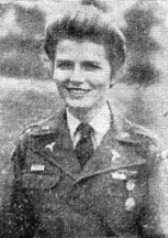
Air Medaled |
IT'S A WOMAN'S WORLD; AIR MEDAL FOR NURSE
ATC BASE, ASSAM - The guy who thought up the old saw about this being a woman's world wasn't kidding! The gals are even getting the Army medals these days.
Lt. Bernice McDonald, a flight nurse, of Burkburnett, Tex., the other day became one of the first women in this neck of the war ever to receive the Air Medal. She got it for completion of operational flights in the evacuation of patients from combat zones.
The award citation credits Lt. McDonald with distinguishing herself "by meritorious achievement while participating in more than 150 hours of operational flight in transport aircraft through the combat zones of Upper Assam, Burma and southwest China." It adds that she has "displayed professional skill, untiring energy and meticulous care while evacuating sick and wounded from forward American and Allied airstrips in Burma to hospitals in India and China."
Lt. McDonald is a former stewardess for American Airlines and served previously as a surgical nurse in the Little Company of Mary Hospital, Chicago, Ill.
BRING ON MORE JAPS FOR 20TH GUNNERS
WESTERN CHINA - (ANS) - A single American B-29 Superfortress shot down seven and damaged two of 79 Japanese fighters which attacked her in a four hour running battle over the enemy homeland while returning from a recent mission, Army intelligence officers have reported.
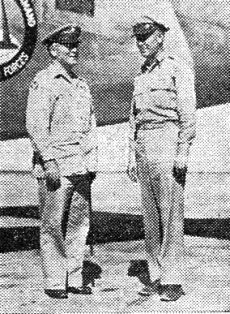
Teamwork Emphasized |
HANLEY, TUNNER
Complete Inspection Trip
HQ. ICD ATC, INDIA - returning recently from their second inspection swing through CBI bases, Maj. Gen. Thomas J. Hanley, Jr., commander of CBI Air Service Command, and Brig. Gen. William H. Tunner, India-China Division, ATC Commander, said they were "particularly impressed with ASC-ATC teamwork" they discovered at all bases visited.
On completion of the inspection and goodwill trip, Tunner lauded ASC personnel for "its exemplary cooperation" and pointed out this assistance was a substantial contributing factor in the accomplishments of the ATC, which have brought recent plaudits from President Roosevelt and Prime Minister Winston Churchill.
"Praise," Tunner asserted, "must be shared with the Air Service Command and other organizations which have given the India-China Division full and continued cooperation. We realize that these accomplishments would have been impossible without this great assistance. We have been getting the tonnage across The Hump and, by working in harmony, we'll continue to lay down increasing amounts of vital war cargo in China."
CBI Air Hero Accused of Accepting Bribes
NEW YORK - (ANS) - Maj. Walter V. Radovich, Los Angeles, who won the DFC for downing four Jap aircraft in Burma, was accused this week of accepting $7,000 to help prevent two Army privates from being shipped overseas.
U.S. Attorney John McGohey charged Radovich also with accepting entertainment, tailored uniforms, and presents for himself and family from relatives of Pvts. Morris Usdan and Martin Bayer, both of New York, for taking steps to avert their transfer to the fighting fronts.
Facing charges of bribery and conspiracy are Jerome Usdan, brother of the private, and Sam and Elias Bayer, who have not yet been apprehended by the FBI.
Radovich is now under detention at Mitchel Field. Usdan is now overseas, while Bayer is still in this country.
SERVED WITH COCHRAN
Radovich, who served with Col. Phil Cochran's Air Commandos, is alleged to have ordered the two privates out of a group alerted for overseas transfer in 1943, and to have had them assigned to medical service. Later, when the two again became slated for combat duty, he ordered them back to his unit until the danger had passed.
According to McGohey, when Radovich's unit was sent to CBI in January, 1944, the flier was eager for combat duty and started off well, once bombing a Jap ammunition train from such a low altitude that the concussion almost wrecked his plane.
On another occasion, he landed in an almost inaccessible spot, overloaded his plane with Allied wounded, and made a successful take-off.
PACE SLACKENED
However, McGohet said, the pace was not maintained and his reactions slowed up so much that his commanding officer feared he was no longer fit for combat duty. Radovich finally confessed the whole story to his commander, saying that while flying he was constantly under the obsession that "God might visit punishment on his child for his sin."
Before the war, Radovich worked on a road gang in California and attended Santa Barbara State Teachers College for two years. He became an Air Cadet before Pearl Harbor. Due to his unusual flying skill, he was selected to organize an Air Commando unit.

|
RESCUED, BUFFALO, ONE EACH
ASSAM - U.S. Army Ordnance can be proud of its weapons carriers, three-quarter ton, w/winch, and here is another reason why:
Cpl. James Little and Pvt. Irving Karp of a Signal Aviation unit were accosted recently by a cheerless Indian on a lonely road in Upper Assam. Wailed the unhappy one:
"Come, Sahibs, I have trouble."
The G.I.'s followed him, Good Samaritan fashion, to the edge of a well.
Peering 20 feet downward, the wondering Yanks perceived a strange sight. This particular well contained one each buffalo, water, complete w/horns, searching the sunlight above with woeful eyes. The beasty's legs, fore and aft, were hobbled beneath his expansive belly, rendering any effort toward self-rescue impossible. And the little brown guy needed his animal back in the rice paddies.
Little and Knapp organized a rescue party. Three Indians were put to work scooping out a sloping trench toward the bottom of the well. Twenty-five feet of winch line were unfurled and the running end hooked around a leathery neck. The motor of the 4 x 4 roared, and 1,000 pounds of buffalo were whisked out of a peculiar predicament.
Said Little: "That buffalo's nose furrowed that trench up like a plow." - By Lt. WILLIAM W. HUGHES
Chinese Recapture Lungling
Roundup Staff Article
Following strong bombing and strafing action by planes of the 14th Air Force, which flew 67 sorties during the last two days of the battle, and aided by U.S. pilots in liaison planes who directed artillery fire, the 11th Group Army of the Salween Expeditionary Force moved into Lungling this week, following a five-day assault starting Oct. 29.
The Jap garrison, which had been reinforced, fell back to Mangshih, followed all the way by the darting planes of the 14th, which bombed a strafed the invaders as they retreated to their last remaining fortress on the Salween front.
MOVED FORWARD
The American-trained Chinese troops of Gen. Wei-li Huang entered the city after repulsing vicious Jap counter-attacks. The Japs apparently intended to make a last-ditch stand, but withdrew after the Chinese had flanked them with road blocks and the armies advancing south from Myitkyina towards Bhamo had threatened them with encirclement.
Aided by the American Y-Force liaison group under Brig. Gen. Frank Dorn, the Salween troops have taken Tengchung, Pingka, Sunshan and Kaolokungshan since the offensive was opened May 11. All of these were strongly-fortified positions.
BITTER FIGHTING
The Chinese had originally occupied most of the city of Lungling on June 10, but the reinforced Jap garrison forced them to retreat from the city. The Japs again took the offensive and regained control of the Lungling terminus of the Lungling-Tengchung road. But the Chinese then re-attacked and took the old town of Lungling, just north of the city, as well as the hill positions dominating the Tengchung road.
From these dominant positions, the Salween forces launched their final successful assault that saw Lungling fall.
B-29's Hammer Singapore
Roundup Staff Article
Super-Forts of the 20th Bomber Command raided the Japanese naval bas of Singapore, the Pangalanan Bandon oil refinery in Sumatra, and hit Rangoon, Burma, during the past week.
All attacks were flown from bases in India, according to communiqu s issued in Washington by the 20th Bomber Command.
The flight to Singapore was the longest daylight mission ever flown by military planes. The raid upon the Pladjoe refinery at Pangalanan, Sumatra last Aug. 10 made at night exceeded the Singapore operation by a few miles.
"Good to excellent" bombing results were reported for the three targets - a control house, dry dock, and a ship in the city dry dock at the Singapore naval base were hit; one direct hit was scored on the refinery in Sumatra; a roundhouse and other important buildings were hit in the Mahlwagon freight yards on the Rangoon raid.
B-29's on the Rangoon raid caused what headquarters of the 20th Bomber Command described as "the largest individual bomb loads ever carried in aerial warfare."
No planes were lost on the three missions as a result of enemy action.
MEDALS FOR 'WALKERS'

|
For meritorious service during Gen. Joseph W. Stilwell's historic retreat from Burma in May, 1942, 10 officers and one enlisted man have been awarded Bronze Stars, while one other officer and one enlisted man were given the Oak Leaf Cluster for their part in the "long walk back."
Those who received the bronze stars were: Maj. Gen. Frank D. Merrill (then a major); Brig. Gens. Frank Dorn (the a lt. col.); Benjamin G. Ferris (then col.) George W. Sliney (then lt. col.) and Fred McCabe (then col.); Col. Robert P. Williams; Lt. Cols. Fred L. Eldridge (then capt.); Paul L. Jones (then capt.) and Gordon S. Seagrave (then major); Capt. Robert J. Belknap (then lt.) and S/Sgt. Lawrence O. Short (then sgt.).
Oak Leaf Clusters to the bronze Star went to: Maj. Richard M. T. Young (then lt.) and S/Sgt. Paul D. Gish (then T/4).
FOUR FIGHT THE HUMP
AIR SERVICE COMMAND BASE - Three American Technical Representatives and an ASC test pilot recently completed months of experimental work during which they purposely flew their new model airplane into the howling gales, sleet and frigid, black clouds over The Hump seeking answers to problems of anti-icing, de-icing and vapor lock in big cargo transport planes.
The Three Tech Reps are Henry D. Redder, and John W. Wells, of the Pratt-Whitney Aircraft division of United Aircraft Corporation, and Richard L. O'Conner, of the Curtiss-Wright Airplane Co. Col. Lloyd R. Davidson was the ASC test pilot.
After long hours of hazardous flight amid the turbulence and sub-arctic cold of Hump storms, the men found the answers to previous troubles. then they spent six weeks at a central India depot improvising new types of instruments for installation in the aircraft, only to lose their "guinea pig" when a zealous pilot thinking the plane was scheduled to go to China, flew it across The Hump, where it was damaged on the ground by enemy air action.
With the aid of ASC technicians the instruments were reproduced in four weeks and final tests were flown, this time over mountainous uncharted areas of northwestern China, near Tibet, an empty, frigid no-man's land called "parachute country" by ATC pilots.
Local modifications and Stateside factory changes were made on the new model as a result of these successful experiments. Davidson was awarded a DFC for his share in the work and Col. Thomas MacDonald, ASC maintenance chief, recommended the Tech Reps for the emblem for Meritorious Civilian Service.
|
G.I.'S BUCK LOCAL BANGTAILS
And Learn About Sport of Clucks
By S/SGT. KARL PETERSON
The American horse race aficionado sojourning in India who decides for a day at the track always misses the first race. Arriving in ample time, he hears the well-mannered bell which denotes "They're Off" (no vulgar raucous klaxon), and gazes eagerly up the track to his left watching for the field to round the turn into the stretch. While the crowd gives vent to subdued enthusiasm, the ponies finally dash into his field of vision from the right, having just concluded the race. He is now formally introduced to Indian horse racing, which proceeds clockwise rather than counter-clockwise, as we know it.
The ponies are a varied lot. Most are sleek, wasp-waisted thoroughbreds in the accepted manner, although the pedigree chart in your racing form booklet is full of "unknown" notations. The horse's sire is listed properly, but the book doesn't give a damn. Other entries include assorted grays (alleged Arabians who look more like your Grandpa's Percheron plowhorse), dun-colored dos, and even two-tone models. One gee-gee at an Indian track who recently spread-eagled a classy field caused some eye-brow raising when it developed he had, the week previous, captured the novelty race for tonga horses.
G.I. lambs, fat with rupees, search for a good bookie. The trouble is, you can't get to a good bookie. India's citizens take their horse-betting very seriously, and dash frantically through the crowds, heedless of toes and shins, seeking the best odds from the various suave characters who stand astride their little wooden structures chanting their hottest offer to the passing flock.
When a bookie strays from the party line and offers higher odds that his mates, a scene ensues which dwarfs anything seen in Chicago's Exchange wheat pit, or in Wall Street on Black Friday, 1929. Bettors literally climb over one another to get their money down, the price maker's pavilion rocks perilously amid the surging mob, and the frantically scribbling bookie, writing tickets, is driven steadily back by a forest of hands clutching bank notes and a babel of voices. Nearby, placid Europeans take quiet tea on the lawn.
One Calcutta track, where the riding is done by non-professional "gentlemen" jockeys, features a ladies event in their racing silks, miladies dash round the oval British style, leaning forward slightly in the saddle, and do a good job withal. On one occasion, however, an American girl who was doing a roping act with the floor show at a local hotel, and a true daughter of the old Wild West, was favored with a mount.
Spectators had practically conceded the race to the English lady with a 70 yard handicap who galloped confidently down the home stretch maintaining a dignified seat, when a flying pony suddenly came from nowhere in a burning stretch drive. Crouched low on his neck, knees tightly doubled beneath her, was the American gal, whip in hand, belaboring the animal fore and aft in best Santa Anita style. She won the race, but lost her social standing.
The Delhi racers have suffered in popularity as a result of the writings of a local newspaper racing correspondent who infers, without much subtlety, that the races are crooked as a dog's hind leg. His criticisms are peculiarly virulent on a Sunday morning when his selections have fared badly the previous afternoon, such as "what happened to this mare today needs an explanation."
He laments that "I have incurred much displeasure of the race officials because of my fair, frank, just and bold criticism," but he still does not spare the whip. In one instance he cried that an entry had been pulled, "the old tight reins" he calls it, "under the stewards' very noses," observing trucently that the winner "is owned jointly by the president and secretary of the racing club." His efforts, or someone's, did bring a shakeup among the club's officials, the "High Command," and in a recent issue he conceded that "today's races were almost fair and clean."
The C.B.I. Roundup is a weekly newspaper of the United States Forces, published by and for the men in China, Burma, and India, from news and pictures supplied by staff members, soldier correspondents, United Press, OWI, and Army News Service. The Roundup is published Thursday of each week and is printed by The Statesman in New Delhi and Calcutta, India. Editorial matter should be sent directly to Capt. Floyd Walter, Hq., U.S.F., I.B.T., New Delhi, India, and should arrive not later than Sunday in order to be included in that week's issue. Pictures must arrive by Saturday and must be negatives or enlargements. Stories should contain full name and organization of sender. Complaints about circulation should be sent directly to Lt. Boyd Sinclair, Hq., U.S.F., I.B.T., New Delhi, India. Units on the mailing list should make notification of any major change in personnel strength or any change of APO.

NOVEMBER 9, 1944
Adapted from the original issue of CBI Roundup
Similar, better quality image of Marjorie Woodworth used in this re-creation.
The Military Railroaders story was untitled in the original newspaper.
Copyright © 2008 Carl Warren Weidenburner
TOP OF PAGE PRINT THIS PAGE ABOUT THIS PAGE SEND COMMENTS
PREVIOUS ISSUE CLOSE THIS WINDOW NEXT ISSUE

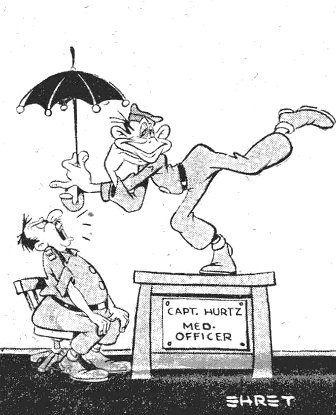
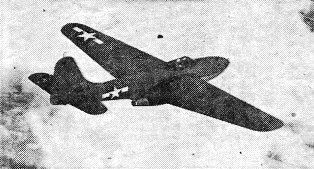
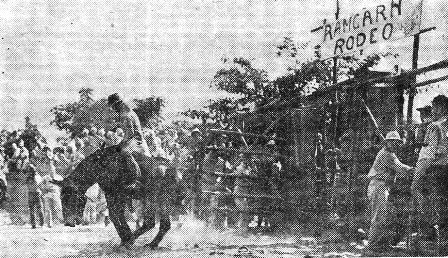 To the stentorian command of "Pour 'em out" over the public address system, the chute gates open to discharge Sgt.
"Frosty" Alsoia, of Mountain Home, Idaho, and his spirited, long-eared steed on a short but eventful journey.
To the stentorian command of "Pour 'em out" over the public address system, the chute gates open to discharge Sgt.
"Frosty" Alsoia, of Mountain Home, Idaho, and his spirited, long-eared steed on a short but eventful journey.
